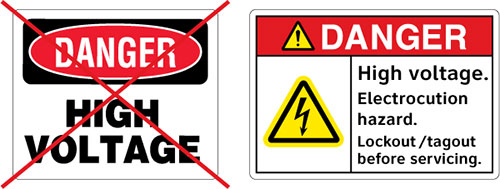Standards and best practices for workplace safety signs
I know that OSHA references the latest ANSI standards in its regulations about safety signs, but many of the signs I see online and in catalogs don’t use these formats. Why are signs that use the latest ANSI standards better for my workplace?

Responding is Derek Eversdyke, director of facility safety products at Clarion Safety Systems, Milford, PA.
We often find that safety professionals are unaware of the progress made in safety sign design standards over the past decade – they don’t realize that the OSHA-style, oval “DANGER” word-message-only safety signs are out of date. And that means most facility safety signs currently in use are out of sync with today’s best practices. Change, however, is on the horizon – and for good reason.
Although OSHA’s regulations continue to maintain references to old safety sign standards (which are the signs you’re seeing online and in catalogs), the agency’s 2013 inclusion of references to the latest ANSI Z535 standards for safety signs makes it clear that OSHA wants to encourage facilities to adopt the newer sign designs – designs that make use of the latest standards-based warnings technology.
But there’s another reason for using the newer signs, one that goes deeper than OSHA compliance. The safety signs you place in your facility aren’t just a quick fix to satisfy regulatory requirements – they can be an effective part of your overall safety and risk reduction program. If you choose to use the newer best practice sign designs, your system of safety and risk communication will have a much better chance of achieving this objective.
Over the past 100 years, both workplaces and the “state-of-the-art” for safety sign design have undergone significant change. In the beginning, in 1914, crude arrow-style signs with the word “DANGER” were used to point to hazards. In 1941, the organization that later became ANSI published the first national standard for safety signs. The signs you are most familiar with today, like “DANGER – HIGH VOLTAGE,” comply with this 1941-era standard. The problem with the old signs is that they:
- Are language-dependent, informing only people who can read English.
- Typically identify only the hazard, not the consequence of interaction with the hazard or how to avoid the hazard.
- Don’t stand out. As one safety professional recently put it, without symbols they “blend into the wallpaper.”

Safety sign standards have significantly evolved since 1941. The ANSI Z535 standards, first published in 1991, ushered in the modern age of U.S. safety sign design. For the first time, safety professionals had sign standards that used the latest advancements in risk communication technology. Graphically based, content-rich and in line with the latest risk assessment/risk reduction methodologies, the newer sign designs represent the state-of-the-art for visual safety communication. As such, they have the added ability to better protect your company from litigation should an incident occur and a lawsuit arise. When it comes to safety communication, lives are on the line – and this is why using the newer sign technology is the right thing to do.
Post a comment to this article
Safety+Health welcomes comments that promote respectful dialogue. Please stay on topic. Comments that contain personal attacks, profanity or abusive language – or those aggressively promoting products or services – will be removed. We reserve the right to determine which comments violate our comment policy. (Anonymous comments are welcome; merely skip the “name” field in the comment box. An email address is required but will not be included with your comment.)

